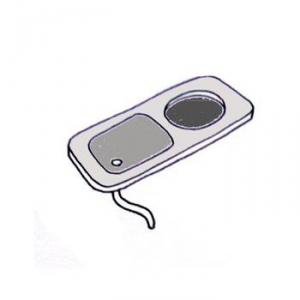The separate collection of urine allows to reduce water used in toilets for flushing and to collect the nutrients contained in the urine in order to reuse them in agriculture. There are urine diversion components for all kind of toilet systems, cultures and climates.
| Entradas | Salidas |
|---|---|
Urine or Yellowwater |
Urine or Yellowwater |
Urine diversion (UD) devices collect urine separately from faeces either without any water or with minimal flush water only. A urine diversion toilet has two outlets with two collection systems: one for urine and one for faeces (and possibly a third one for anal wash water), in order to keep these two (or three) excreta/wastewater fractions separate. The approach of source separation of urine is based on the fact that urine contains most of the nutrients in domestic wastewater, but makes up less than one percent of the total wastewater volume (see also sanitation systems). UD toilets may, or may not, mix water and faeces, or some water and urine, but they never mix urine and faeces. Basically there are two main types of urine diversion toilets: UD toilets without flush water (these are called urine diversion dehydration toilets or UDDTs) and those with flush water (UD flush toilets) (MUENCH & WINKLER 2009).
The purpose of a UD installation is usually one, or several of the following four purposes – which can be split in two categories (Adapted from: MUENCH & WINKLER 2009):
Purposes relevant for all types of UD systems
- To reduce water consumption.
- To be able to collect urine pure and undiluted so that it can – after sanitisation by storage – be safely used as fertiliser in agriculture (see also the nutrient cycle).
Purposes relevant for UDDTs
- To reduce odour and flies.
- To avoid production of wet, odorous faecal sludge, which has to be removed by someone.
There are several toilet systems, where urine separation is implemented very successfully (learn more about: vacuum toilets, urine diversion flush toilets, UDDTs, composting toilets, terra preta toilets, fossa alterna). From very simple composting toilets to low-flush toilets, there are different components available on the market all around the world that make it possible to collect urine from toilets separately in a user friendly way. Another great possibility to collect urine are waterless urinals (see picture below).
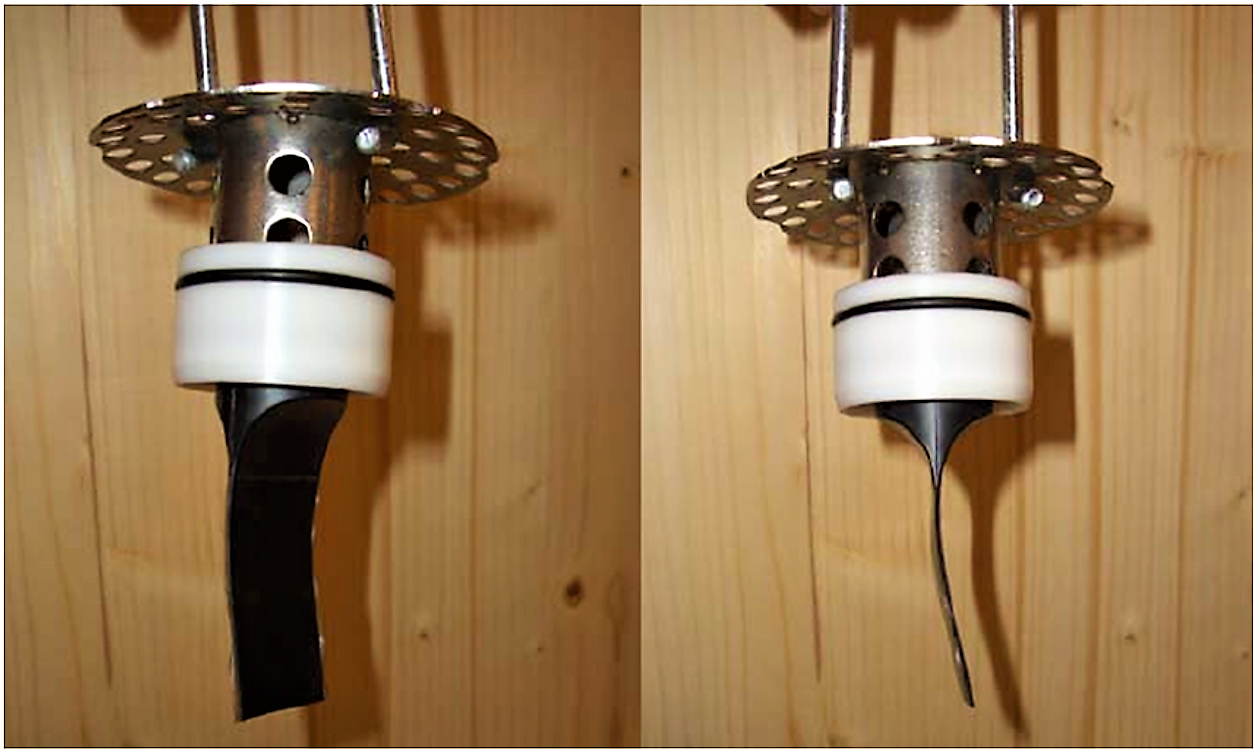
The big difference is made between UD flush toilets and waterless toilet systems. The GTZ compiled a list about UD flush toilets, UDDT and urinal manufactures (MUENCH 2010). The following photos show examples from all around the world.

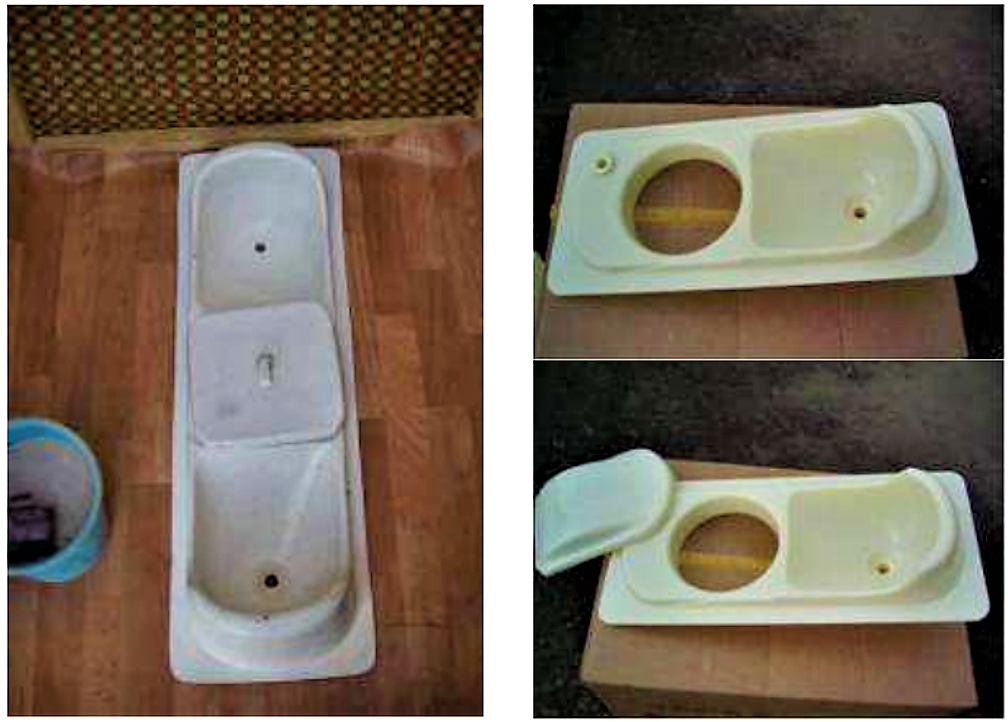
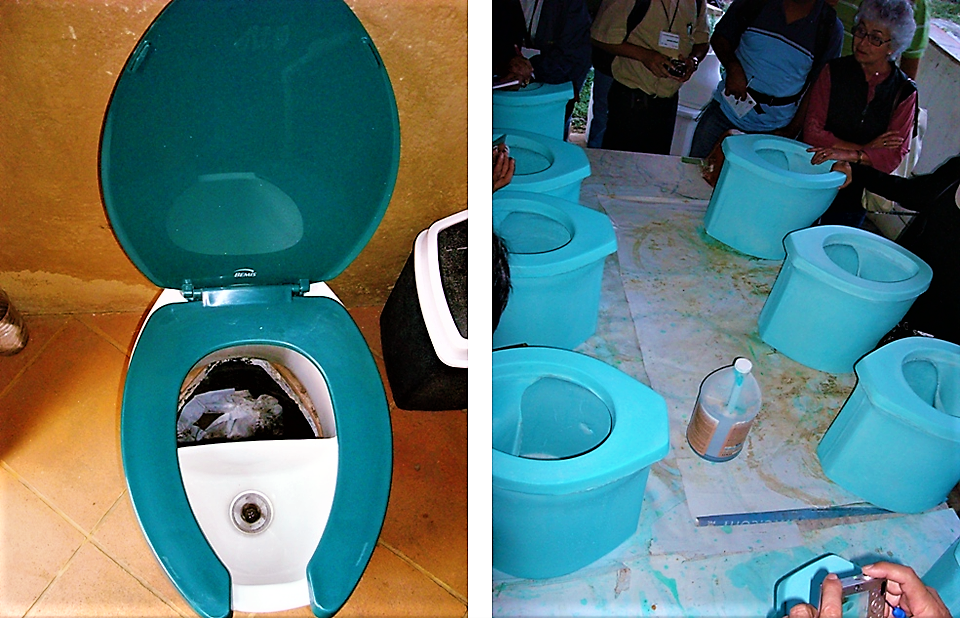
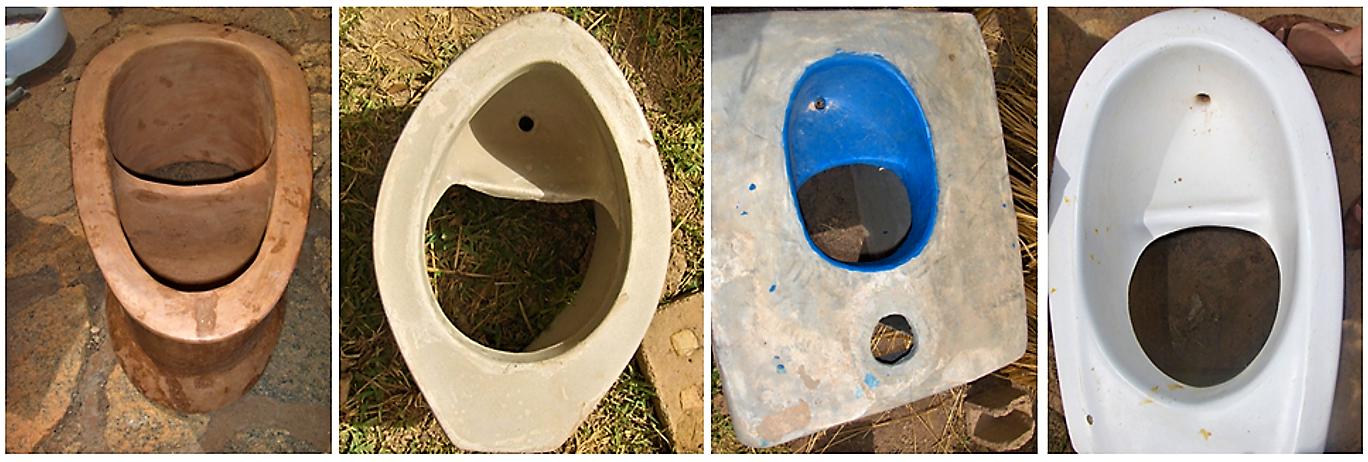
For urine storage, there are prefabricated tanks for large-scale collection/storage or tanks made out of locally available materials. Collected urine than needs to be treated before reuse, the most common treatments today are storage, struvite precipitation or evaporation.
Costs depend on the toilet type and country. There are luxury models, which are quite expensive (e.g. UD vacuum toilet system), but also very simple and cheap composting toilets or UD dehydration toilets. If residents/farmers use urine (small scale and large scale), struvite and dehydrated or composted faeces (see also small scale and large scale, they can save the costs for industrial fertiliser and bring nutrients back into the nutrient cycle.
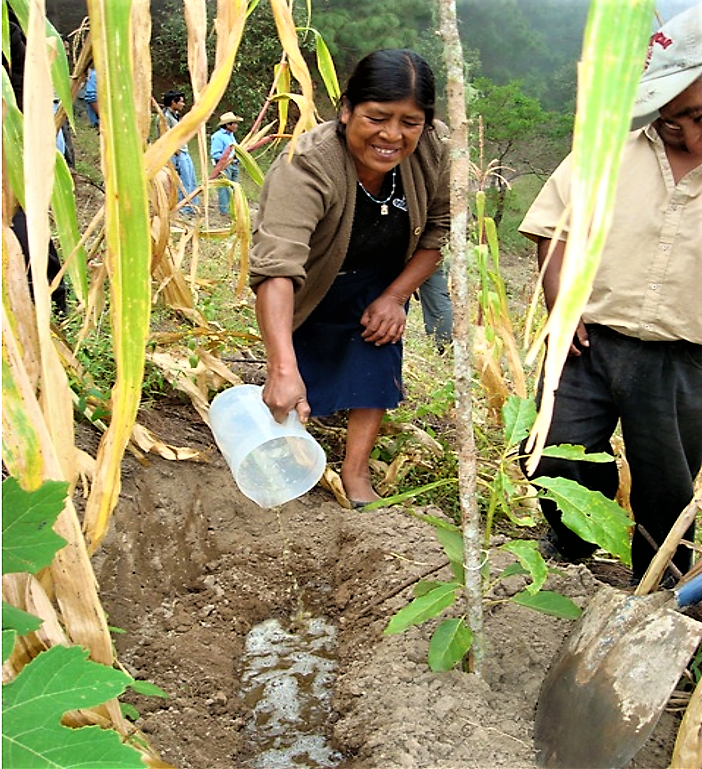
It should be maintained like every toilet and kept in a clean condition. But care has to be taken in order to prevent dilution of urine with soap and water (from cleaning) or contamination with faeces (if the urine diversion component is not correctly used). Operation and maintenance also depends on the toilet system. If users handle with urine and faeces, caution is required. Especially faeces contain pathogens and could be endangering operators. Users need to be instructed about O&M and hygienic aspects.
| Working Principle | The toilet bowl or squatter pan is divided in two sectors. The sector in the front is for urine which can be collected separately. Faeces are either digested (see also anaerobic digestion), composted in a pit/tank, or flushed away. |
| Capacity/Adequacy | Urine diverting components can be added to almost every toilet system. |
| Performance | For every toilet system there is a suitable solution to optimise the performance. |
| Costs | From very cheap types to expensive toilet systems. |
| Self-help Compatibility | Depends on type. Several UD and UDDT toilets can be built/repaired by locals and with local available materials. |
| O&M | It should be maintained like every toilet and kept in a clean condition. Dilution of urine with soap and water or contamination with faeces needs to be prevented. |
| Reliability | If well maintained and constructed, high. |
| Main strength | Urine (and faeces) can be collected separately and reused as fertiliser. |
| Main weakness | Needs more attention than a common flush toilet. The users should be motivated to collect and reuse urine. |
It is applicable with all kind of toilet systems, in every culture and countries/climates.
Urine diversion components. Overview of Urine Diversion Components such as Waterless Urinals, Urine Diversion Toilets, Urine Storage and Reuse Systems
The publication explains the purposes of urine diversion, its benefits and challenges, possibilities of urine treatment and reuse in agriculture. It provides an overview on design and operational aspects for equipment needed, such as waterless urinals and urine diversion toilets. An appendix with a worldwide listing of suppliers for waterless urinals and urine diversion toilet pedestals and squatting pans is also available.
MUENCH, E., v. WINKER, M. GTZ (2009): Urine diversion components. Overview of Urine Diversion Components such as Waterless Urinals, Urine Diversion Toilets, Urine Storage and Reuse Systems. (= Technology Review ). Eschborn: German Agency for Technical Cooperation (GTZ) GmbH URL [Visita: 31.05.2019]Appendix: Worldwide Listing of Suppliers for Waterless Urinals and Urine Diversion Toilet Pedestals and Squatting Pans
This document contains a worldwide listing of suppliers for waterless urinals and urine diversion toilet pedestals and squatting pans.
MUENCH, E. (2010): Appendix: Worldwide Listing of Suppliers for Waterless Urinals and Urine Diversion Toilet Pedestals and Squatting Pans. (= Technology Review ). Eschborn: German Agency for Technical Cooperation (GTZ) URL [Visita: 31.05.2019]UDD-Toilets and Urine Management
Technology Review of Urine-Diverting Dry Toilets (UDDTs)
This publication offers a complete overview of UDDT functions, design considerations, common operation and maintenance issues and generalised installation costs. Its focus is on applications in developing countries and countries in transition, although UDDTs are also applicable in developed countries.
RIECK, C. MUENCH, E. HOFFMANN, H. (2012): Technology Review of Urine-Diverting Dry Toilets (UDDTs). Overview on Design, Management, Maintenance and Costs. (= Technology Review ). Eschborn: German Agency for Technical Cooperation (GTZ) GmbH URL [Visita: 11.05.2019]Guidelines on the Use of Urine and Faeces in Crop Production
These guidelines provide a thorough background on the use of urine (and faeces) for agricultural purposes. Aspects discussed are requirements for plant growth, nutrients in excreta, hygiene aspects, and recommendations for cultivation. It provides detailed guidance on the use of urine for purposes.
JOENSSON, H. RICHERT, A. VINNERAAS, B. SALOMON, E. (2004): Guidelines on the Use of Urine and Faeces in Crop Production. (= EcoSanRes Publications Series , 2004 ). Stockholm: EcoSanRes URL [Visita: 17.04.2012]Urine Diversion - One Step Towards Sustainable Sanitation
This report of Stockholm environment institute (SEI) presents the current state-of-the-art (2006) of urine-diverting systems, focusing on the Swedish experience and what can be learned from that experience. The intention is to inspire decision- and policy-makers to consider urine diversion for sanitation interventions aimed at meeting the sanitation target of the Millennium Development Goals.
KVARNSTROEM, E. EMILSSON, K. RICHERT STINTZING A. JOHANSSON, M. JOENSSON, H. PETERSENS, E. SCHOENNING, C. CHRISTENSEN, J. HELLSTROEM, D. QVARNSTROEM, L. RIDDERSTOLPE, P. DRANGERT, J.O. (2006): Urine Diversion - One Step Towards Sustainable Sanitation. (= EcoSanRes Publication Series ). Stockholm: Stockholm Environment Institute (SEI) URL [Visita: 27.07.2010]Appendix 1 for technology review of urine diversion components
This document contains a worldwide list of suppliers for waterless urinals. The tables of suppliers provided here are not complete listings but give only an indication of available products. If you spot errors or omissions, please contact the authors at ecosan@giz.de. In the brackets below each listing the date for provision of the information/last update of information is given. Please be aware that not all information is from 2011. An entry in this list does not imply a recommendation by GIZ. Costs are indicative only.
MUENCH, E., v. WINKER, M. GIZ (2011): Appendix 1 for technology review of urine diversion components. Worldwide listing of suppliers for waterless urinals. (= Technology Review ). Eschborn: Deutsche Gesellschaft für Internationale Zusammenarbeit (GIZ) GmbH URL [Visita: 31.05.2019]Practical Guidance on the Use of Urine in Crop Production
This practical guideline on the use of urine in agricultural productions gives some background information on basic plant requirements and how they can be met with urine as a liquid fertiliser.
RICHERT, A. GENSCH, R. JOENSSON, H. STENSTROEM, T.A. DAGERSKOG, L. (2010): Practical Guidance on the Use of Urine in Crop Production. (= EcoSanRes Publication Series, Report No. 2010-1 ). Stockholm: Stockholm Environment Institute (SEI) URL [Visita: 26.05.2019]Guidelines on the Safe Use of Urine and Faeces in Ecological Sanitation Systems
These guidelines provide a thorough background on the safe use of urine and faeces for agricultural purposes. Aspects like the health risk associated we the use of human excreta in agriculture and how to limit them are discussed.
SCHOENNING, C. STENSTROEM, T.A. (2004): Guidelines on the Safe Use of Urine and Faeces in Ecological Sanitation Systems. (= EcoSanRes Publication Series ). Stockholm: Stockholm Environment Institute (SEI)UDD-Toilets and Urine Management
How to Make Simple Pedestals
This presentation offers the chance to learn about how to make different kinds of pedestals.
MORGAN, P. SHANGWA, A. (2009): How to Make Simple Pedestals. The Chisungu Primary School Water and Sanitation project. Stockholm : Ecological Sanitation Research (EcoSanRes), Stockholm Environment Institute (SEI) URL [Visita: 31.05.2019]UDD-Toilets and Urine Management
UDD Toilets in Rural School Hayanist, Armenia
This case study reports the establishment of a sustainable, affordable and safe school sanitation system in a rural area in Armenia. A total number of 7 Double-Vault UDDTs serve ca. 350 students (females and males) and 26 staff members. Urine is stored for 6 months before application.
DEEGENER, S. SAMWEL, M. ANAKHASYAN, E. (2009): UDD Toilets in Rural School Hayanist, Armenia. (= SuSanA - Case Studies ). Eschborn: Sustainable Sanitation Alliance (SuSanA) URL [Visita: 07.07.2010]Improved traditional composting toilets with urine diversion, Leh, Jammu and Kashmir State, India - draft
In Leh, a small town in Jammu and Kashmir, people try to replace traditional sanitation systems by waterborne toilet systems. This project tries to revitalise the traditional ecological sanitation practice that is threatened to fall into oblivion. Different improvements of the traditional Ladhaki toilets are suggested. Due to an extremely dry climate, it is possible to process human excreta indoors without prior diversion of urine, by using a combination of soil composting and dehydration.
DAWA, S. KREUTZER, G. PANESAR, A. (2009): Improved traditional composting toilets with urine diversion, Leh, Jammu and Kashmir State, India - draft. (= SuSanA - Case Studies ). Eschborn: Sustainable Sanitation Alliance (SuSanA) URL [Visita: 31.05.2019]Urine and brownwater separation at the GTZ main office building, Eschborn, Germany
This case study is about a demonstration project in the headquarters of GTZ in Eschborn, Germany. The project consists of 50 urine-diversion flush toilets, 23 waterless urinals and 10 m³ urine storage tank.
WINKER, M. SADOUN, A. (2011): Urine and brownwater separation at the GTZ main office building, Eschborn, Germany. (= SuSanA - Case Studies ). Eschborn: Sustainable Sanitation Alliance (SuSanA) URL [Visita: 12.05.2019]Guidelines on the Safe Use of Urine and Faeces in Ecological Sanitation Systems. Factsheet No. 5
This factsheet is a short version of the guidelines for the safe use of urine and faeces for agricultural purposes providing information on the health risk associated we the use of human excreta in agriculture and how to limit these.
ECOSANRES (2008): Guidelines on the Safe Use of Urine and Faeces in Ecological Sanitation Systems. Factsheet No. 5. (= EcoSanRes Factsheet, No. 5 ). Harare (Zimbabwe): Stockholm Environment Institute EcoSanRes Programme URL [Visita: 20.07.2010]Guidelines on the Use of Urine and Faeces in Crop Production. Factsheet
A 2-page factsheet summarizing the EcoSanRes ‘Guidelines on the Use of Urine and Faeces in Crop Production’ publication with short information on urine as a fertilizer, application rates etc.
ECOSANRES (2008): Guidelines on the Use of Urine and Faeces in Crop Production. Factsheet. (pdf presentation). (= EcoSanRes Factsheet , 6 ). Stockholm: Stockholm Environment Institute URL [Visita: 31.05.2019]

